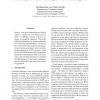Free Online Productivity Tools
i2Speak
i2Symbol
i2OCR
iTex2Img
iWeb2Print
iWeb2Shot
i2Type
iPdf2Split
iPdf2Merge
i2Bopomofo
i2Arabic
i2Style
i2Image
i2PDF
iLatex2Rtf
Sci2ools
ACL
2007
2007
Domain Adaptation with Active Learning for Word Sense Disambiguation
When a word sense disambiguation (WSD) system is trained on one domain but applied to a different domain, a drop in accuracy is frequently observed. This highlights the importance of domain adaptation for word sense disambiguation. In this paper, we first show that an active learning approach can be successfully used to perform domain adaptation of WSD systems. Then, by using the predominant sense predicted by expectation-maximization (EM) and adopting a count-merging technique, we improve the effectiveness of the original adaptation process achieved by the basic active learning approach.
ACL 2007 | Active Learning Approach | Computational Linguistics | Domain Adaptation | Word Sense Disambiguation |
| Added | 29 Oct 2010 |
| Updated | 29 Oct 2010 |
| Type | Conference |
| Year | 2007 |
| Where | ACL |
| Authors | Yee Seng Chan, Hwee Tou Ng |
Comments (0)

